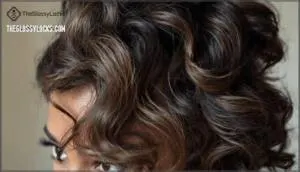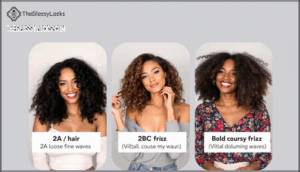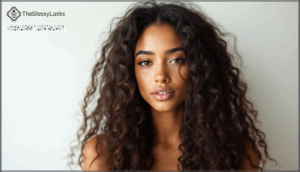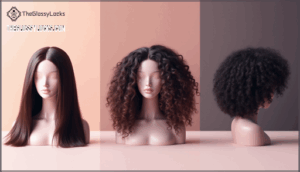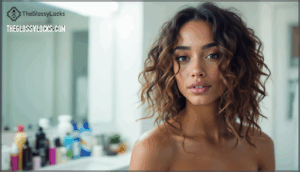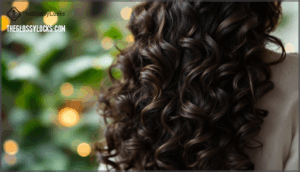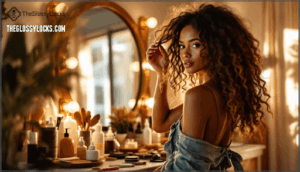This site is supported by our readers. We may earn a commission, at no cost to you, if you purchase through links.
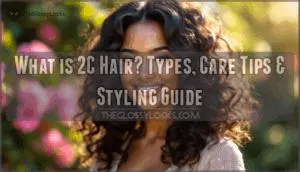
If your hair puffs up in humidity, never lies flat, and seems to have a mind of its own, you know the daily balancing act—taming the wild bends without weighing down that hard-earned wave.
Understanding what is 2C hair means seeing the beauty in its bold texture and learning how to keep those waves healthy, defined, and full of life.
Table Of Contents
- Key Takeaways
- What is 2C Hair?
- How to Identify 2C Hair
- 2C Hair Vs. Other Hair Types
- Common Challenges for 2C Hair
- Best Care Routine for 2C Hair
- Top Styling Tips and Products for 2C Hair
- Frequently Asked Questions (FAQs)
- How do I tell if my hair is 2B or 2C?
- What does 2C hair look like?
- Am I 2C or 3A hair?
- What does 2A hair look like?
- How do I know if my hair is 2B or 2C?
- Is 2C hair curly or wavy?
- What haircut is best for 2C hair?
- Can 2C hair become more curly over time?
- What causes 2C hair to lose its waves?
- How does weather affect 2C hair texture?
- Conclusion
Key Takeaways
- 2C hair features thick, defined S-shaped waves from root to tip, giving you noticeable volume and a higher risk of frizz.
- This hair type sits between wavy and curly, with more texture and fullness than straight hair but less spiral and shrinkage than true curls.
- Managing 2C hair means balancing moisture, gentle detangling, and lightweight styling products to keep waves healthy and defined.
- Humidity, product buildup, and improper care can cause dryness, frizz, and loss of wave definition, so smart routines and protective techniques are key.
What is 2C Hair?
If you’ve been wondering whether your hair is wavy or curly, understanding 2C hair might clear things up. This hair type sits right at the edge of the wavy category, with characteristics that set it apart from looser wave patterns.
Let’s break down what makes 2C hair unique, starting with where it fits in the bigger picture.
The Type 2 Hair Category
Type 2 hair sits right in the ideal zone between straight and curly, and it’s divided into three distinct wave patterns that each have their own personality. Understanding these wavy hair types helps you choose the right products and styling techniques for your hair texture.
- 2A hair has loose, barely-there waves that lie close to the scalp
- 2B hair shows more defined S-shaped waves with moderate volume
- Type 2C hair features the boldest wave pattern with noticeable texture from root to tip
Defining Features of 2C Hair
What sets 2C hair apart from its wavy cousins is the pronounced S-shaped pattern that kicks in right at your roots and travels all the way down to your ends. This 2C hair type brings natural root lift and noticeable volume thanks to its wider wave diameter.
You’ll notice more bends and turns throughout each strand compared to finer wave patterns, making identifying 2C hair straightforward once you understand these defining 2C hair characteristics and how strand thickness affects your overall texture.
S-Shaped Wave Pattern Explained
That S-shaped wave isn’t just a visual feature—it’s the signature pattern that gives your 2C hair its bounce, fullness, and sometimes that stubborn frizz you’re working to tame. The root S shape creates lift from your scalp, while pattern variation means some strands might show tighter bends or looser waves.
You’ll often see spiral ends where the wave definition intensifies, and this texture naturally creates more surface area—that’s your frizz connection right there with type 2C hair.
How to Identify 2C Hair
If you’re wondering whether your hair fits the 2C category, there are a few things to look for. These features can help you spot the difference between 2C and other wavy types.
Let’s go through the key signs together.
Visual Characteristics of 2C Hair
You’ll see strong wave definition, with each strand showing clear bends and turns. Root lift is noticeable, giving your hair volume from the scalp. Strand thickness can vary, but frizz patterns often pop up along the curves. Hair shine may look uneven, thanks to those textured waves.
Understanding 2C hair means spotting this bold, defined hair pattern.
Differences Between 2A, 2B, and 2C
Looking closely at Hair Type Differences, you’ll notice wave definition gets stronger from 2A to 2C hair.
2A waves are loose, with finer hair thickness and easier sebum distribution. 2B shows more texture and moderate frizz susceptibility.
2C hair stands out for its bold waves, coarser texture, higher frizz, and unique styling adaptability within wavy hair. Those with 2C hair often find that hydration is very important for maintaining their hair.
Signs You Have 2C Hair
Spotting 2C hair often starts with noticing those deep, root-to-tip waves that seem to maintain their shape no matter how you style or wash them. Look for a Root S-Shape, strong Wave Definition, and a noticeable Frizz Factor.
A quick Volume Check and feeling your Hair Texture can help confirm you’re dealing with the distinct 2C hair pattern.
2C Hair Vs. Other Hair Types
When you look at 2C hair, it stands out from straight and curly types in a few important ways. Understanding these differences can help you care for and style your waves with confidence.
Let’s break down what sets 2C apart from other hair types.
Comparison With Straight and Curly Hair
Ever wonder how 2C hair stacks up against straight and curly hair types? Think of it as the middle ground—more texture and volume than straight hair, but less spiral and shrinkage than curly hair.
Here’s a quick breakdown:
| Hair Type | Texture Differences | Volume Comparison |
|---|---|---|
| Straight | Sleek, smooth | Low |
| 2C | Defined waves | Medium-High |
| Curly | Spirals, coarse | High |
Hair follicles with curves produce curly hair, while straight follicles produce straight hair fibers. Porosity levels, styling ease, and manageability issues all set 2C hair apart. The shape of the hair follicle structure determines hair type.
2C Vs. 3A Hair Differences
Think of 2C and 3A hair as neighbors on the curl spectrum—one leans toward waves with an "S" shape, while the other steps into true curls with spirals that start to bounce.
For a quick side-by-side, check out this table:
| Feature | 2C Hair |
|---|---|
| Curl Definition | Wavy “S” |
| Hair Porosity | Medium |
| Product Needs | Lightweight |
| Styling Techniques | Scrunching |
| Shrinkage Factor | Low |
| 3A Hair | Spiraled |
| High | |
| Rich | |
| Twisting | |
| Noticeable |
Unique Texture and Density
If you’ve ever run your fingers through 2C hair, you’ll notice it’s got a lively bounce and fullness that sets it apart from both straighter and curlier types. The wave diameter is wide, strand thickness varies, and density gives impressive volume.
Here’s a quick breakdown:
| Feature | 2C Hair Highlights |
|---|---|
| Wave Diameter | Wide, visible “S” |
| Strand Thickness | Medium to thick |
| Porosity Levels | Moderate |
| Density Impact | High volume |
| Product Absorption | Quick, needs light |
Common Challenges for 2C Hair
Every hair type has its own set of hurdles, and 2C hair is no exception. You might notice some patterns that show up more often with waves this defined.
Here are a few common challenges you’ll want to keep in mind.
Prone to Frizz and Dryness
Struggling with hair frizz and dryness is almost a rite of passage for 2C hair. Your waves lose moisture fast, thanks to their S-shape and cuticle damage from humidity effects or product buildup.
Maintaining moisture in 2C hair means balancing lightweight conditioners and protein treatments, while preventing frizz in 2C waves requires smart choices to protect your hair’s natural hydration.
Managing Tangles and Breakage
Gentle Detangling is key—reach for a wide-tooth comb and work from the ends up to avoid hair breakage and split ends. Product buildup can make knots worse, so keep your scalp health in check.
Hydration Balance matters, too; well-moisturized hair tangles less. Protective Styles like loose braids help minimize hair detangling struggles overnight.
Maintaining Volume Without Weighing Down
Root clipping lifts your waves at the scalp, while product layering with Lightweight mousses or Plumping Primer keeps hair volume up without stickiness.
Volumizing shampoos help you start light, and the Diffuser technique lets you dry 2C hair gently for maximum bounce.
Smart hair styling techniques and the right styling products make all the difference.
Best Care Routine for 2C Hair
Caring for 2C hair means finding a routine that keeps your waves healthy and defined. The right steps can help you manage frizz and keep your hair looking its best. Here’s what to focus on for a care routine that works.
Ideal Washing Frequency
How often should you wash your 2C hair, and what really works to keep those waves looking fresh without losing their bounce? It depends on your scalp oiliness, product buildup, and seasonal adjustments.
For a balanced 2C Hair Wash Routine, consider:
- Listen to your scalp
- Adjust for hair porosity
- Try gentle cleansing methods
- Watch for buildup
- Adapt your hair care routine
Conditioning and Moisture Tips
To keep your 2C waves hydrated without losing volume, it’s essential to focus on leave-in efficacy. Lightweight leave-ins can significantly boost hair moisture while controlling frizz. Additionally, deep conditioning once a week enhances elasticity, and maintaining a humectant balance helps prevent dryness and excess frizz. The importance of emollients is evident in the shine and softness they impart to your hair.
Here’s a quick table summarizing practical tips:
| Tip | Benefit | Product Type |
|---|---|---|
| Lightweight leave-in | Frizz control | Spray/cream |
| Deep condition | Elasticity | Mask/cream |
| Humectant balance | Moisture, less frizz | Gel/serum |
| Emollient-rich | Shine, softness | Oil/conditioner |
Detangling and Drying Techniques
While your 2C waves can look stunning, getting them detangled and dry without a fuss takes a bit of know-how and the right approach.
Wet detangling with a wide-tooth comb prevents breakage, while a microfiber towel or hair towel helps reduce frizz.
Air drying works well, but using a diffuser can accentuate your wave pattern and speed up drying.
Top Styling Tips and Products for 2C Hair
Styling 2C hair can feel tricky, but it’s easier with the right approach. You’ll want products and techniques that bring out your waves without weighing them down.
Here’s what to look for when choosing your styling routine.
Enhancing and Defining Waves
If you’re hoping to coax out the full beauty of your 2C waves, the right techniques can turn a hidden ripple into a standout feature. Scrunching techniques bring out wave clumps, while product layering helps lock in curl definition.
Using a diffuser method boosts volume and shape, and reviving waves between washes keeps your wavy hair looking lively.
Recommended Lightweight Stylers and Gels
A good lightweight styler or gel can make all the difference when you’re aiming for defined waves without heavy buildup or sticky residue. For 2C hair, consider these Styling Products for Wavy Hair:
- Curl cream for hydration
- Hair gel with flexible grip strength
- Gel casting for definition
- Product layering for control
- Ingredient analysis for gentle application techniques
Nighttime Protection and Frizz Control
Ever wake up to a halo of frizz or flattened waves that seem to have a mind of their own overnight? Try using a silk or satin pillowcase, or a sleeping cap for less friction.
The pineapple method keeps waves defined, satin bonnets protect texture, and loose braids offer extra frizz control. Product application before bed helps, too.
Frequently Asked Questions (FAQs)
How do I tell if my hair is 2B or 2C?
Spot the difference by checking your wave definition and root lift.
2C hair brings fuller waves starting at the scalp, higher frizz levels, and feels thicker—especially if product impact and hair porosity change your hair pattern quickly.
What does 2C hair look like?
When life hands you waves, 2C hair shows it with bold S-shapes from root to tip. You’ll notice root lift, strong wave definition, and medium strand thickness.
2C hair stands out with bold S-shaped waves from root to tip, delivering noticeable lift and defined texture
This hair pattern features a lively curl pattern and noticeable hair porosity.
Am I 2C or 3A hair?
Wondering if your hair is 2C or 3A? Look for wave definition and curl diameter.
2C hair has strong S-shaped waves with root lift and more frizz, while 3A shows spirals and a tighter curl pattern.
What does 2A hair look like?
Fine 2A hair sits close to straight, with a subtle wave that starts mid-shaft. You’ll notice gentle bends and minimal root lift, making it easy to style straight.
Volume boost is tricky, and product buildup can weigh down this hair type.
How do I know if my hair is 2B or 2C?
Imagine your hair as a cassette tape—2B wavy hair plays a gentle wave with moderate frizz, while 2C hair cranks up root lift, wave definition, and frizz levels, needing stronger product grip for that bold hair pattern.
Is 2C hair curly or wavy?
2C hair sits on the Curl Continuum between wavy and curly, but it’s classified as wavy hair.
The hair pattern shows strong Wave Definition, influenced by Genetic Factors, making Styling Impact and Hair Typing especially important.
What haircut is best for 2C hair?
Layered cuts work well for 2C hair, enhancing natural wavy texture and volume.
Consider your face shape, length options, and bang styles. Choose layers that suit your maintenance needs and keep hair styling manageable for everyday life.
Can 2C hair become more curly over time?
Changes in hair elasticity, hormonal shifts, and product buildup can affect your 2C hair’s curl pattern.
Genetic factors and damage impact how wavy hair evolves, so your hair type may appear curlier or looser over time.
What causes 2C hair to lose its waves?
Like a garden losing its shape without care, 2C hair can lose waves from product buildup, humidity effects, protein overload, poor sleep habits, and damage causes.
High hair porosity and frizz also disrupt wavy hair patterns.
How does weather affect 2C hair texture?
Humidity and Frizz go hand in hand, especially for 2C hair. Seasonal Changes, Temperature Effects, and UV Damage can zap hair moisture, causing dryness or frizz. Product Adjustments help maintain hair hydration and improve hair frizz control year-round.
Conclusion
Waves, wild and wondrous, weave their own story—especially when you’re learning what’s 2C hair. With the right care, your strands stay strong, supple, and striking, never surrendering to frizz or flatness.
Embrace your hair’s natural bends, blending moisture, movement, and mindful styling for healthy, head-turning texture. Whether you’re detangling, defining, or dreaming up new looks, remember: 2C hair’s strength lies in its spirited shape. Let your unique waves lead the way, every single day.

